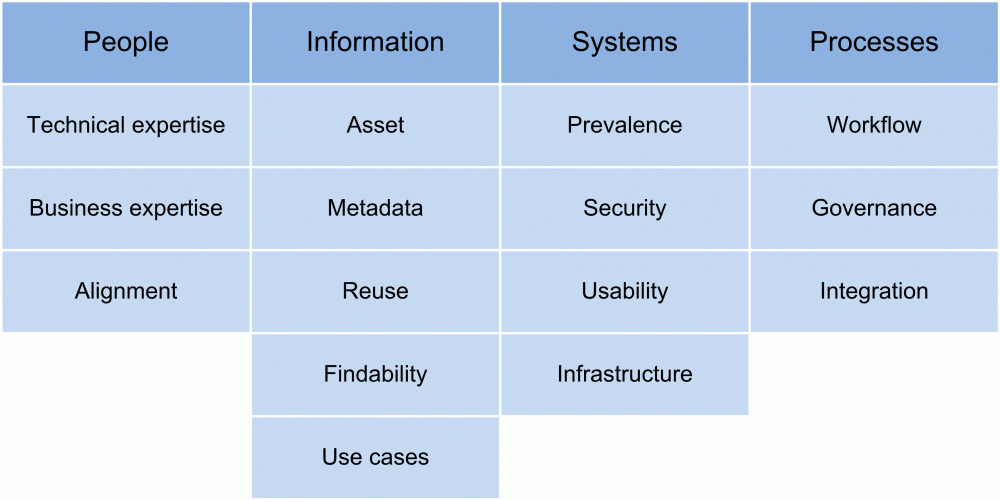By: Doug Collins
Media firms such as the BBC, HBO, and Corbus, along with brand-drive organizations such as Visa and the Estee Lauder Companies, hire people to manage their digital assets. Digital assets include content such as television shows, movies, photographs, and advertisements. Viewers and consumers create their own content, too, in response to shows and brands. Co-creation introduces new challenges for digital asset managers, including deciding what content to manage. In this article innovation architect Doug Collins explores possibilities for digital asset managers to apply the practice of collaborative innovation to help them do their own work more effectively.
I carry on my person a basic black notebook made by the Moleskine Company. The pages never fray. It fits neatly in the inner pocket of my sports coat. The inside cover contains a useful vanity. On three ruled, labeled lines, the owner can write his or her name, contact information, and the value of any reward they wish to offer the person who finds a wayward tome.
I specify twenty dollars as my reward. Twenty dollars seems like a nice, round number for a finder’s fee. I lack a more accurate way to value my scribbling. My Moleskine contains critical perspective on clients. Its pages reveal, too, mind maps that highlight various destinations for lunch.
Twenty dollars seems about right.
The people at the Moleskine Company got the inside cover right. The notebook can hold an asset—content—that the owner values above and beyond the material cost of the paper and glue.
Lots of creative assets have value. The previous season of Mad Men has value. So, too, does last fall’s campaign by cosmetics brand Clinique. Organizations hire people to manage their content as digital assets. Digital asset managers help their organizations identify, track, and recognize the economic value of the assets the organization owns or for which it has rights to use.
An idea (e.g., an idea for a TV show or ad campaign) becomes an asset the moment someone, somewhere, decides to commit the concept to paper or hard drive. From this early creative stage the asset may go through several evolutions, from production through distribution (e.g. to your iPhone) to archive, where it awaits re-use (figure 1).
Figure 1: managing content
Which Episode of Star Wars?
An organization has an incentive to know everything about its assets, from the moment of conception to the moment of obsolescence. This vision runs afoul of the reality of day-to-day operations. Capturing the metadata that defines and identifies content (e.g., the episode of Star Wars filmed in 1989) has a way of falling off people’s to do list.
As a result, the people who manage their organization’s digital assets face an on-going challenge of convincing their colleagues that tracking the organization’s assets early and often is time well spent. Everyone wants health: few commit to cutting the snacks and running around the reservoir each morning. At the same time, the proliferation of content motivates organizations to instill robust means of managing the associated assets. Otherwise, they risk being overwhelmed by the deluge, which may include valuable material that can generate revenue and build brands.
The practice of collaborative innovation, the source of some of the proliferation as a form of co-creation, can also serve as the digital asset manager’s best friend.
The practice of collaborative innovation, the source of some of the proliferation as a form of co-creation, can also serve as the digital asset manager’s best friend. This individual seeks buy-in on the value of developing robust workflows. They can pose this question to the people who participate in the workflow. This individual seeks to reassure their colleagues that the workflows they put in place will withstand the rigors of the daily production environment. They can invite their colleagues to explore opportunities for reducing risk and for identifying contingencies for which to plan (i.e. disaster recovery).
The act of asking a question is the act of seeking authentic engagement. Half the battle that the digital asset manager faces is in convincing their colleagues that workflows matter enough to be a priority. The first question, posed in a genuine way, represents an initial step in that direction.
Where to Start?
The DAM Foundation recently published a maturity model to define the optimal set of systems and processes for the digital asset management ecosystem. The maturity model can serve as a useful place to start in defining intent, relative to the innovation blueprint that I describe in a previous article. As always, intent is contextual: allow your circumstances to define your practice. The maturity model may serve as a good place to start (figure 2).
Figure 2: headings for the DAM Foundation’s maturity model
The model indicates that an organization enjoys maturity in its practice of digital asset management when it achieves the optimal level of competency relative to people, systems, processes, and information.
Let’s say that, for this example, you, as the digital asset manager seek optimal alignment as a function of your people competencies. The DAM Foundation defines this level as …
Proactive use and refinement of DAM capabilities to uncover current and future asset value.
As the digital asset manager and as the practitioner of collaborative innovation you tackle the first C – the critical question – of the three C’s that define collaborative innovation.
First, you focus on the end goal: value: deriving value. Organizations manage assets because they assign value to them. Your first question follows.
How might we maximize the value of the content for which we have rights?
A second, more focused question may follow.
How might we increase the likelihood that we maximize the value of assets we plan to produce or acquire over the next 12 months?
Knowing what you have serves as the first step in driving revenue from the content.
The distinction between current and future assets may be important for cases where the organization already has assets in archive. Knowing what you have – having an accurate inventory – serves as the first step in driving revenue from the content.
Next, you address the second C, community. Who do you want to engage on this question? As a thought exercise, you draw a value chain for the development of new (current) assets tied to the first question of (figure 3).
Figure 3: the community associated with the content workflow
You value the perspective from the people who work in each of these groups. People involved in the creative side, for example, may identify economic value in being able to find current, stored content as a way to re-use materials for promo purposes, for example. The contracts staff may see economic value in being able to readily identify the pedigree of content to confirm that the organization does, in fact, have rights to distribute it: an opportunity for operational efficiency.
Inviting each stakeholder group to engage on the critical question gives them the opportunity to express their preferences and priorities. Workflow has many masters.
Lastly, you enlist the practice of collaborative innovation to explore the third of the three C’s: commitment. Let’s say that your community agrees on the most compelling ideas for deriving value from current and/or future assets. What commitment does each group make to (a) fund the development of workflow, if needed, and (b) support the process by capturing thee needed metadata, given the use case(s) in question? Do the people who contribute the most compelling ideas get the chance to serve in an advisory capacity in helping the organization realize their benefit?
In other words, the critical question leads to community and the community leads to commitment. If the stakeholders that comprise the community cannot commit to pursuing the workflows that satisfy their needs, then you have a good indicator that further, deeper engagement is needed.
Parting Thoughts
Crowd sourcing and crowd funding proliferate content that ties to your organization’s digital assets. Invited or not, an increasing number of people create their own meaning with your organization’s producers and brand managers.
What possibilities do you see in applying collaborative engagement to your own work in order to help your organization realize the full value of its digital assets?
What meaning do you seek to make with your stakeholders as a first step towards effecting authentic transformation in terms of how the organization relates to its content?
People who practice collaborative innovation find that the first stop starts with finding the question that goes to the heart of your business. By contrast, organizations have perceived digital asset management as largely a technology play: What tools do we need to capture the metadata that can help us find a valuable asset? Digital asset management, when coupled with collaborative innovation, offers the possibility for authentic transformation. By applying them in tandem, people have the opportunity to realize their potential for leadership in how they think about maximizing the value of the content. Leadership starts with enquiry.
By Doug Collins
About the author:
 Doug Collins is an Innovation Architect who has specialized in the fuzzy front end of innovation for over 15 years. He has served a variety of roles in helping organizations navigate the fuzzy front end by creating forums, venues, and approaches where the group can convene to explore the critical question. As an author, Doug explores the critical questions relating to innovation in his book Innovation Architecture, Practical Approaches to Theory, Collaboration and Implementation. The book offers a blueprint for collaborative innovation. His bi-weekly column appears in the publication Innovation Management.
Doug Collins is an Innovation Architect who has specialized in the fuzzy front end of innovation for over 15 years. He has served a variety of roles in helping organizations navigate the fuzzy front end by creating forums, venues, and approaches where the group can convene to explore the critical question. As an author, Doug explores the critical questions relating to innovation in his book Innovation Architecture, Practical Approaches to Theory, Collaboration and Implementation. The book offers a blueprint for collaborative innovation. His bi-weekly column appears in the publication Innovation Management.


